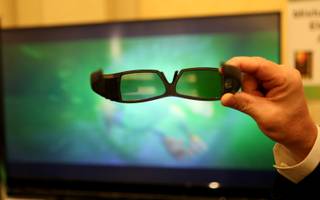Thursday, Jan. 7, 2010 | 2:05 a.m.
Related stories
- Gadgets and garters: It’s convention in Las Vegas (1-7-2010)
- Sony aims to become global leader in 3-D (1-7-2010)
- Microsoft anticipates 'biggest year ever' for the Xbox (1-6-2010)
- Las Vegas braces for 110,000 at Consumer Electronics Show (1-6-2010)
- Consumer Electronics hot ticket: 3-D television (1-6-2010)
- Analysts predict flat electronics sales for 2010 (1-6-2010)
- What others are saying about CES (1-6-2010)
Remember the first time you used a computer mouse?
It probably was a somewhat clunky experience that you got the hang of in a minute or so. And it opened the door to navigating around your computer with ease.
Now, a small startup company that considers Henderson its home has engineered a new navigation tool that is getting its largest public exposure at this week’s Consumer Electronics Show.
Pierre Bonnat, co-founder and chief architect of Zyxio, has developed the SensaWaft Micro Electro-Mechanical System — a fancy name for new technology that allows people to control their computers by air flow, blowing onto a microchip sensor mounted in a boom on a headset. It looks just like a standard telephone headset.
Control is achieved by force and direction of the air flow. Those differences in force and direction are converted by the chip into commands.
It only took most people a few minutes to get the feel for moving a cursor and executing commands with their breath when Zyxio Marketing Vice President Celine Vignal took the device to the Strip last year. Vignal showed people how to scroll, zoom in and out of documents and change computer settings by blowing into the device.
Bonnat expects SensaWaft to be a hit among computer users who need hands-free navigation options — commanding “smart phones,” moving quickly with game consoles and as a standard navigation tool for the disabled.
Bonnat began developing the device in 2005, splitting his time between Southern Nevada and Silicon Valley, before settling in Henderson because of the high cost of maintaining an office in California.
He raised seed money from investors in California and Utah, securing 20 patents for his device. He was working primarily in “stealth mode” until 2009.
Bonnat expects to ship the first SensaWaft devices by the second quarter of this year.
Last year, Bonnat and Vignal went to the public for the best ideas to apply the technology, developing their “Be a Mindblower” competition online.
The company put out an appeal to tech fans worldwide to come up with ideas for incorporating the device into everyday computer applications.
The “Be a Mindblower” competition began in November with a solicitation of ideas and an invitation to sit on a panel of judges to choose the best applications.
“We believe that involving users in the development process of our future products is of utmost importance as they will be the ones incorporating our touchless technology into their everyday lives,” Bonnat said.
At the end of November, Zyxio narrowed the field of mind-blowing ideas to 25, then solicited voting to narrow the 25 to the top five.
The field of 25 was allowed to promote their ideas with blogs and videos on Zyxio’s pages on popular social media sites. To encourage voter participation, those rating the ideas were entered into a drawing to win a Samsung Go netbook or a Motorola Droid smartphone.
The top five vote-getters will sit on an advisory board for six months and will guide the development of the new products. They’ll also get $6,000 each and a three-day trip to Las Vegas to interact with the Zyxio team.
Details on the winning entries were scheduled to be unveiled at CES on Jan. 7.
“We’ve really seen some incredible ideas,” Bonnat said. “Some enable people with disabilities an easier way to give commands. With this technology, you can develop a password that you blow or turn pages on your Kindle digital reading device by blowing.”
Gabriel Rebeiz, a professor at the Jacobs School of Engineering at the University of California-San Diego and an adviser to Zyxio, doesn’t expect the SensaWaft technology to replace the mouse, but he thinks it will open opportunities for new products.
Rebeiz said he is impressed with the device’s sensor capabilities to small variations of breath pressure and direction and how well it filters out wind and other background phenomena, even in the earliest versions of the device.
Richard N. Velotta covers tourism, technology and small business for In Business Las Vegas and its sister publication, the Las Vegas Sun. He can be reached at 259-4061 or at [email protected].



Join the Discussion:
Check this out for a full explanation of our conversion to the LiveFyre commenting system and instructions on how to sign up for an account.
Full comments policy